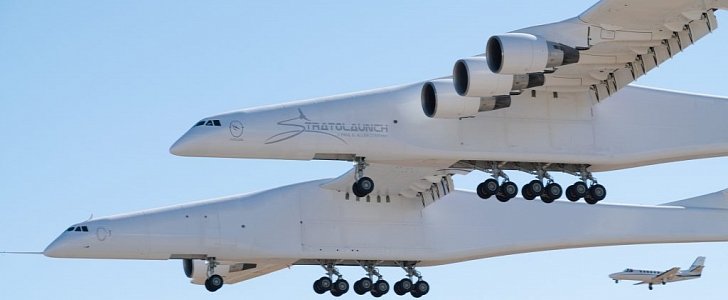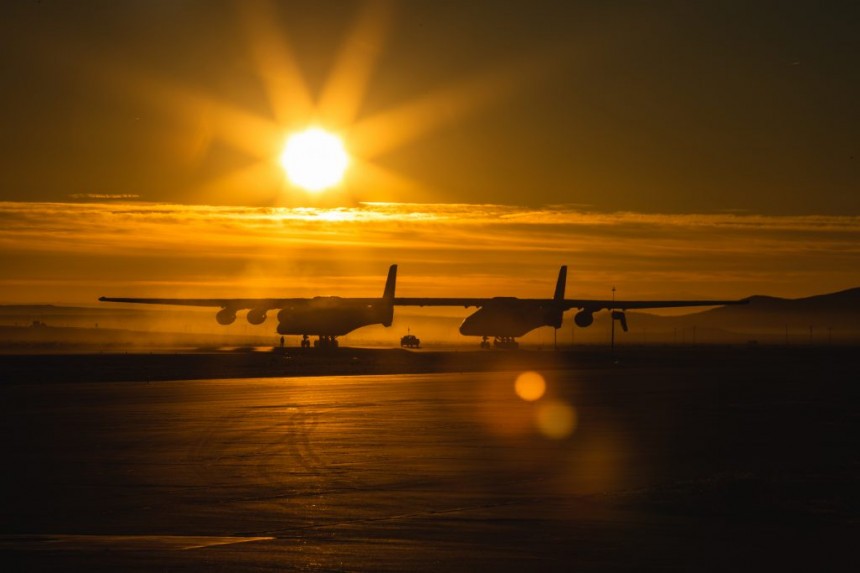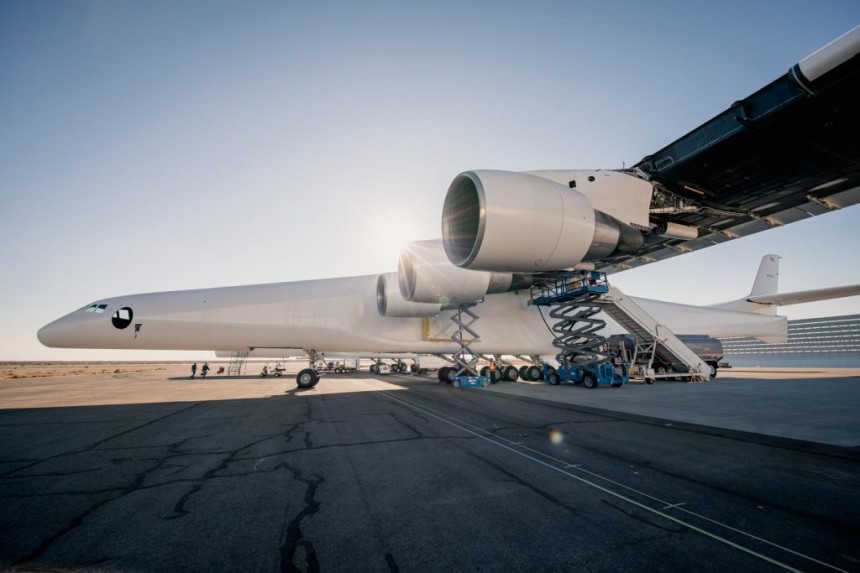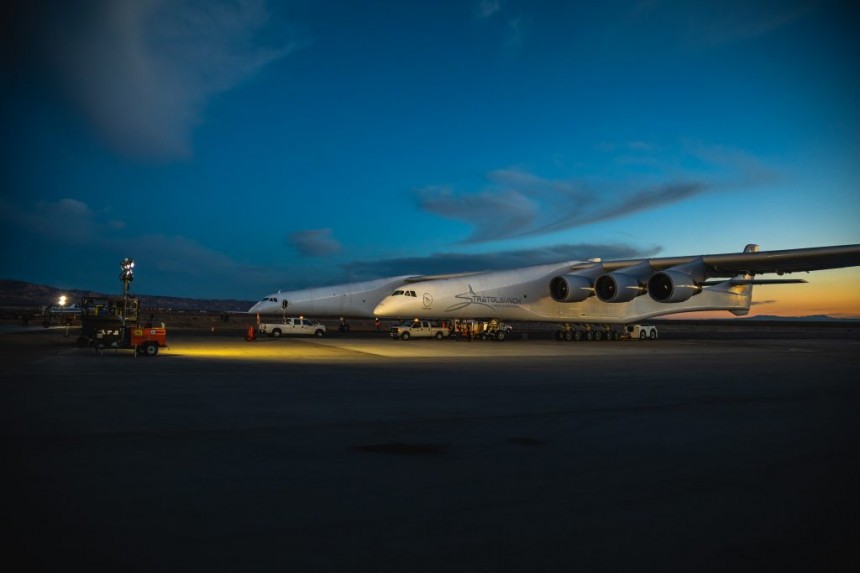For more than 70 years, the Hughes H-4 Hercules, nicknamed Spruce Goose, held the record for the largest wingspan aircraft that has ever flown. With a length of nearly 320 feet (97,5 meters) and a height of 218 feet (66,6 meters) this giant flying boat was definitely something that commanded respect.
The record was actually set with a prolonged take-off, as its first and only “flight” lasted no more than 26 seconds, but still, it was enough to deserve the title. Something to admire taking into account that all this took place in 1947.
Nonetheless, it took 72 years for someone to have a successful attempt on breaking that record, and it was no other than the mammoth Stratolaunch Model 351, a plane designed to launch rockets and their cargo into orbit. The record for the largest flying aircraft was broken in April 2019, but the story dates back a number of years.
In 2011, one of Microsoft’s founders, Paul Allen, announced his intention to build an aerial vehicle for flying into the stratosphere and delivering “goods” into orbit. The chosen partner for this journey, Burt Rutan, an accomplished aerospace design engineer, was supposed to directly involve his company Scaled Composites in the creation of the aircraft, and so he did.
In the original plans, SpaceX was expected to produce a liquid-fueled rocket to help Stratolounch lift the payload of the aerial vehicle into space, but the collaboration was ended in the final months of 2012.
In an interview for Space Flight Insider in 2015, former president Chuck Beames stated: "SpaceX was a partner, and like a lot of partnerships, it was just determined that it was best we went our separate ways – different ambitions. We were interested in their engines, but Elon and his team, they're about going to Mars”.
Fast forward to 2017, and the Model 351 was rolled out for the first time, for a long series of ground tests. The plane featured a twin-fuselage configuration with an astonishing wingspan of 385 feet (117 meters) – longer than most football fields - and a total of 28 wheels. There are more than a few similarities with the company’s White Knight Two aircraft that was introduced in 2008, with each fuselage having its own empennage, a design that seemed to work for Scaled Composites, so why not build on it then?
This design allowed the crew to be accommodated in the right fuselage cockpit, with the one on the left holding the flight data systems, but apart from that, unpressurized emptiness.
As if the record breaking 385 feet wasn’t enough, the airplane is powered by six Pratt & Whitney PW4056 engines also used on planes such as the Boeing 747-400, providing around 56,750 lbf (252.4 kN) of thrust from each engine. The combined power of the engines is good enough to carry a 550,000 lb (250 tons) payload between the two fuselages.
As a side note, in order to reduce some of the production costs, the engines are not the only things that were shared with the Boeing, as the list goes on with the landing systems, flight deck, avionics and several others.
Partner that up with the airplane’s own weight, as well as the over 200,000 lb of fuel (100 tons) and you get a bewildering figure that surpasses the million pound threshold, truly impressive.
Fully loaded, the Model 351 requires a runway of 12,000 feet (3,700 meters) for takeoff, and should be able to release its “cargo” at around 35,000 feet (11,000 meters), hence the nickname “Roc” after the Arabian mythical bird that was so massive it could carry an elephant in its claws at high altitudes.
In April 2019, the Model 351 took off for the first time. Though we do not have a confirmed date for the first time the Model 351 will launch a payload into the stratosphere, it is assumed that the company will take an airport-style approach towards launching operations, as the plane can deliver payloads to multiple orbits and inclinations.
Nonetheless, it took 72 years for someone to have a successful attempt on breaking that record, and it was no other than the mammoth Stratolaunch Model 351, a plane designed to launch rockets and their cargo into orbit. The record for the largest flying aircraft was broken in April 2019, but the story dates back a number of years.
In 2011, one of Microsoft’s founders, Paul Allen, announced his intention to build an aerial vehicle for flying into the stratosphere and delivering “goods” into orbit. The chosen partner for this journey, Burt Rutan, an accomplished aerospace design engineer, was supposed to directly involve his company Scaled Composites in the creation of the aircraft, and so he did.
In an interview for Space Flight Insider in 2015, former president Chuck Beames stated: "SpaceX was a partner, and like a lot of partnerships, it was just determined that it was best we went our separate ways – different ambitions. We were interested in their engines, but Elon and his team, they're about going to Mars”.
Fast forward to 2017, and the Model 351 was rolled out for the first time, for a long series of ground tests. The plane featured a twin-fuselage configuration with an astonishing wingspan of 385 feet (117 meters) – longer than most football fields - and a total of 28 wheels. There are more than a few similarities with the company’s White Knight Two aircraft that was introduced in 2008, with each fuselage having its own empennage, a design that seemed to work for Scaled Composites, so why not build on it then?
As if the record breaking 385 feet wasn’t enough, the airplane is powered by six Pratt & Whitney PW4056 engines also used on planes such as the Boeing 747-400, providing around 56,750 lbf (252.4 kN) of thrust from each engine. The combined power of the engines is good enough to carry a 550,000 lb (250 tons) payload between the two fuselages.
As a side note, in order to reduce some of the production costs, the engines are not the only things that were shared with the Boeing, as the list goes on with the landing systems, flight deck, avionics and several others.
Partner that up with the airplane’s own weight, as well as the over 200,000 lb of fuel (100 tons) and you get a bewildering figure that surpasses the million pound threshold, truly impressive.
In April 2019, the Model 351 took off for the first time. Though we do not have a confirmed date for the first time the Model 351 will launch a payload into the stratosphere, it is assumed that the company will take an airport-style approach towards launching operations, as the plane can deliver payloads to multiple orbits and inclinations.





















